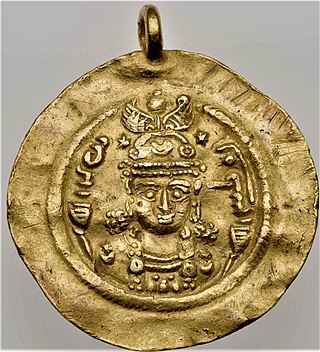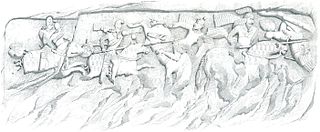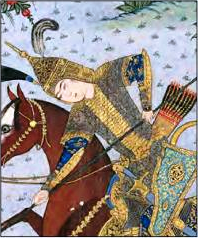Related Research Articles

Khosrow II, commonly known as Khosrow Parviz, is considered to be the last great Sasanian king (shah) of Iran, ruling from 590 to 628, with an interruption of one year.

Shapur I was the second Sasanian King of Kings of Iran. The precise dating of his reign is disputed, but it is generally agreed that he ruled from 240 to 270, with his father Ardashir I as co-regent until the death of the latter in 242. During his co-regency, he helped his father with the conquest and destruction of the city of Hatra, whose fall was facilitated, according to Islamic tradition, by the actions of his future wife al-Nadirah. Shapur also consolidated and expanded the empire of Ardashir I, waged war against the Roman Empire, and seized its cities of Nisibis and Carrhae while he was advancing as far as Roman Syria. Although he was defeated at the Battle of Resaena in 243 by Roman emperor Gordian III, he was the following year able to win the Battle of Misiche and force the new Roman emperor Philip the Arab to sign a favorable peace treaty that was regarded by the Romans as "a most shameful treaty".

Artabanus IV, also known as Ardavan IV (Parthian:𐭓𐭕𐭐𐭍), incorrectly known in older scholarship as Artabanus V, was the last ruler of the Parthian Empire from c. 213 to 224. He was the younger son of Vologases V, who died in 208.

Boran was Sasanian queen (banbishn) of Iran from 630 to 632, with an interruption of some months. She was the daughter of king Khosrow II and the Byzantine princess Maria. She is the second of only three women to rule in Iranian history, the others being Musa of Parthia, and Boran's sister Azarmidokht.

Rostam Farrokhzād was a dynast from the Ispahbudhan family, who served as the spahbed of the northwestern quarter (kust) of Adurbadagan under the Sasanian monarchs Boran and Yazdegerd III. Rostam is remembered as a historical figure, a character in the Persian epic poem Shahnameh, and as a touchstone of many Iranian nationalists.
The Seven Great Houses of Iran, also known as the seven Parthian clans, were seven feudal aristocracies of Parthian origin, who were allied with the Sasanian court. The Parthian clans all claimed ancestry from Achaemenid Persians.

Bahrām Chōbīn or Wahrām Chōbēn, also known by his epithet Mehrbandak, was a nobleman, general, and political leader of the late Sasanian Empire and briefly its ruler as Bahram VI.

The Battle of Hormozdgan was the climactic battle between the Arsacid and the Sasanian dynasties that took place on 28 April 224. The Sasanian victory broke the power of the Parthian dynasty, effectively ending almost five centuries of Parthian rule in Iran, and marking the official start of the Sasanian era.
Farrukhzad was an Iranian aristocrat from the House of Ispahbudhan and the founder of the Bavand dynasty, ruling from 651 to 665. Originally a powerful servant of the Sasanian king Khosrow II, he, along with several other powerful aristocrats made a conspiracy against the latter and ended his tyrannical rule. They thereafter put Khosrow's son Kavadh II on the throne, whose rule lasted only a few months, before he was killed by a plague, being succeeded by his son Ardashir III, who was only after one year murdered by the rebellious former Sasanian army chief (spahbed) Shahrbaraz, who usurped the throne.

Vistahm or Bistam, was a Parthian dynast of the Ispahbudhan house, and maternal uncle of the Sasanian king of kings of Iran, Khosrow II. Vistahm helped Khosrow regain his throne after the rebellion of another Parthian noble Bahram Chobin, of House of Mihran, but later led a revolt himself, and ruled independently over a region which encompassed the entire Iranian East until he was defeated by Khosrow and his allies.

The Sasanian civil war of 589–591 was a conflict that broke out in 589, due to the great deal of dissatisfaction among the nobles towards the rule of Hormizd IV. The civil war lasted until 591, ending with the overthrow of the Mihranid usurper Bahram Chobin and the restoration of the Sasanian family as the rulers of Iran.

Adurbadagan was a Sasanian province located in northern Iran, almost corresponded to the present-day Iranian Azerbaijan. Governed by a marzban ("margrave"), it functioned as an important frontier region against the neighbouring country of Armenia.

Farrukh Hormizd or Farrokh Hormizd, also known as Hormizd V, was an Iranian prince, who was one of the leading figures in Sasanian Iran in the early 7th-century. He served as the military commander (spahbed) of northern Iran. He later came in conflict with the Iranian nobility, "dividing the resources of the country". He was later killed by Siyavakhsh in a palace plot on the orders of Azarmidokht after he proposed to her in an attempt to usurp the Sasanian throne. He had two children, Rostam Farrokhzad and Farrukhzad.
Piruz Khosrow, also known as Piruzan or Firuzan, was a powerful Persian aristocrat who was the leader of the Parsig (Persian) faction that controlled much of the affairs of the Sasanian Empire during the Sasanian civil war of 628-632. He was killed at the Battle of Nahāvand in 642.
The Sasanian civil war of 628–632, also known as the Sasanian Interregnum was a conflict that broke out after the execution of the Sasanian king Khosrow II between the nobles of different factions, notably the Parthian (Pahlav) faction, the Persian (Parsig) faction, the Nimruzi faction, and the faction of general Shahrbaraz. Rapid turnover of rulers and increasing provincial landholder power further diminished the empire. Over a period of four years and fourteen successive kings, the Sasanian Empire weakened considerably, and the power of the central authority passed into the hands of its generals, contributing to its fall.
Isfandyadh was an Iranian aristocrat from the Ispahbudhan family, who was the ruler of the Sasanian province of Adurbadagan. He was the son of the powerful Sasanian general Farrukhzad, who was the brother of Rostam Farrokhzad and the son of Farrukh Hormizd.
Narsi or Narse, was an Iranian nobleman who served as the Sasanian governor of Kashkar.
Darigbed was a Sasanian title equivalent to the Byzantine title kouropalates ("palace superintendent"). The title is first mentioned in the inscription of Shapur II at Naqsh-e Rostam.

Gordiya was an influential Iranian noblewoman from the House of Mihran, who was first the sister-wife of the distinguished military leader Bahram Chobin, then the wife of the Ispahbudhan dynast Vistahm, and ultimately the wife of the last prominent Sasanian emperor, Khosrow II.

Dara II or Darab II was the last king of the mythological Kayanian dynasty, ruling between 14 and 16 years. He is generally identified with Darius III, the last king of the Achaemenid Empire. In Middle Persian literature and Islamic chronicles, he is generally known as "Dara", while he is known as "Darab" in the New Persian proses Darab-nama and Iskandar-nama. He was the son and successor of Dara I.
References
- ↑ Pourshariati 2008, p. 49.
- ↑ Howard-Johnston 2010.
- ↑ Shapur Shahbazi 1989, pp. 180–182.
- ↑ Shapur Shahbazi 2002, pp. 171–176.
- ↑ Pourshariati 2008, pp. 26–27.
- 1 2 Shahbazi 1989, pp. 180–182.
- ↑ Lewental 2017b.
- 1 2 Pourshariati 2008, p. 278.
- ↑ Pourshariati 2008, p. 279.